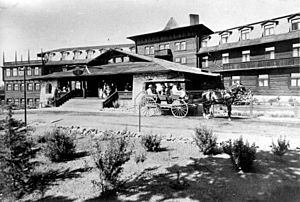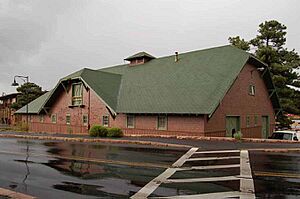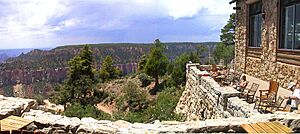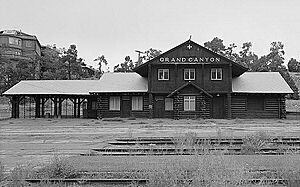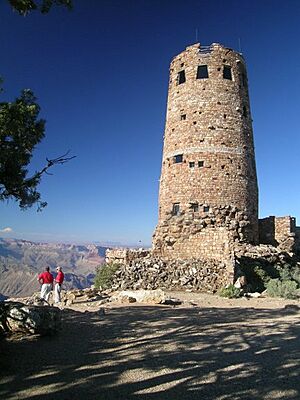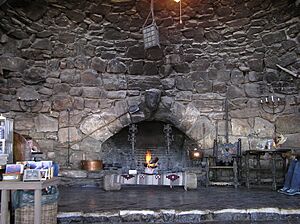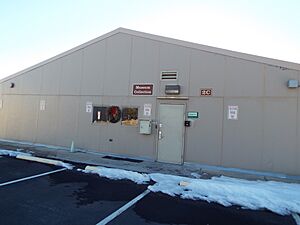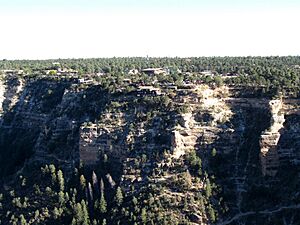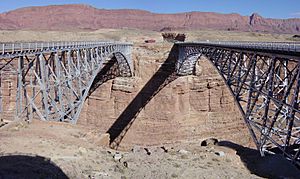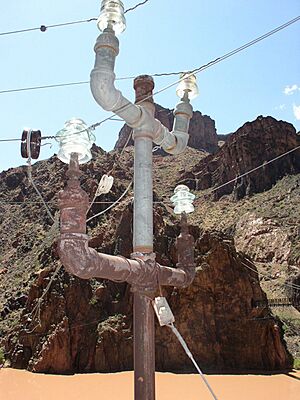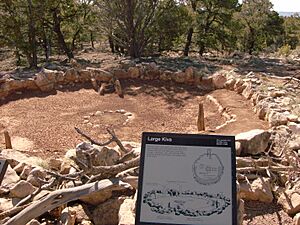National Register of Historic Places listings in Grand Canyon National Park facts for kids
The Grand Canyon National Park in Arizona, United States, is famous for its amazing natural beauty. But did you know it's also home to many important historic places? These special spots are listed on the National Register of Historic Places. This list helps protect buildings, sites, and objects that are important to American history.
There are 23 places in Grand Canyon National Park that are on this list. Seven of these are even more special and are called National Historic Landmarks. This means they are super important to the history of the entire country! Let's explore some of these cool historic sites.
Contents
Historic Places at Grand Canyon National Park
Famous Buildings and Structures
The Grand Canyon has many buildings that tell stories of its past.
El Tovar Hotel: A Grand Stay
The El Tovar Hotel is a very old and fancy hotel right on the South Rim of the Grand Canyon. It was built a long time ago, in 1905, and was designed to look like a mix of Swiss chalets and Norwegian villas. It's a National Historic Landmark because it's a great example of early 20th-century hotel design and played a big role in making the Grand Canyon a popular tourist spot. Imagine staying there over 100 years ago!
El Tovar Stables: Mule Power!
Near the El Tovar Hotel are the El Tovar Stables. These stables were built to house the mules that take visitors down into the Grand Canyon. Mules are still used today for these trips, so these stables are a living piece of history!
Grand Canyon Lodge: North Rim Views
On the North Rim of the Grand Canyon, you'll find the Grand Canyon Lodge. This lodge and its cabins offer amazing views of the canyon. It was built in the 1920s and is also a National Historic Landmark. It's a great example of how buildings were designed to fit into the natural landscape of national parks.
Grand Canyon Railroad Station: A Journey Back in Time
The Grand Canyon Depot, also known as the Grand Canyon Railroad Station, is a historic train station. It was built in 1910 and is the end of the line for the Grand Canyon Railway. This railway brought many early visitors to the park. It's a National Historic Landmark because it's a unique example of a rustic train station built for a national park.
Mary Jane Colter's Amazing Designs
Many of the Grand Canyon's most famous buildings were designed by a talented architect named Mary Jane Colter. Her buildings are known for blending in with the natural surroundings and often look like they're made from the earth itself. Several of her designs are National Historic Landmarks, including:
- Desert View Watchtower: This tall stone tower offers incredible views of the canyon and the Colorado River. It was built in 1932 and looks like an ancient Pueblo Indian tower.
- Hermit's Rest: This rustic building was designed to look like a hermit's dwelling. It has a huge fireplace and offers a cozy place for visitors to relax.
- Hopi House: Located near the El Tovar Hotel, this building was designed to look like a traditional Hopi pueblo. It was built to sell Native American crafts.
- Lookout Studio: Perched right on the canyon rim, this small stone building offers a perfect spot for visitors to take photos and enjoy the views.
Other Important Historic Sites
Beyond the main buildings, other sites tell important stories.
1956 Grand Canyon Mid-Air Collision Site
This site marks the location of a tragic airplane accident in 1956. Two airplanes, TWA Flight 2 and United Airlines Flight 718, crashed into each other over the Grand Canyon. All 128 people on board both planes died. This event led to major changes in how air traffic is controlled in the United States, making flying much safer today. It's a very important site for aviation history.
Horace M. Albright Training Center
The Horace M. Albright Training Center is a place where park rangers and other National Park Service employees learn how to do their jobs. It's named after Horace M. Albright, who was an important early director of the National Park Service. This center has helped train many people who work to protect our national parks.
Grand Canyon Village Historic District
The Grand Canyon Village Historic District is the main developed area on the South Rim. It includes many of the historic buildings we've talked about, like the El Tovar Hotel and the Railroad Station, as well as other important structures like employee housing and utility buildings. It's a National Historic Landmark because it shows how national parks were developed for tourism in the early 1900s.
The Navajo Bridge is a steel arch bridge that crosses the Colorado River near Lees Ferry, just outside the main Grand Canyon area. It was built in 1929 and was the only bridge crossing the Colorado River for hundreds of miles for a long time. It was very important for travel and trade in the region. A newer bridge was built next to it in 1995, but the old bridge is still there for pedestrians.
Trans-Canyon Telephone Line
Imagine trying to communicate across the vast Grand Canyon before cell phones! The Trans-Canyon Telephone Line was an amazing engineering feat. It connected the North and South Rims of the canyon, allowing park staff and visitors to communicate. It followed trails like the Bright Angel and North Kaibab Trails. This line was very important for park operations and safety.
Tusayan Ruins
The Tusayan Ruins are the remains of an ancient Pueblo village. They show how people lived in this area over 800 years ago. There's also a small museum nearby where you can learn about the ancient cultures of the Grand Canyon. It's a fascinating look into the lives of the first people who called this land home.
These historic places help us understand the rich history of Grand Canyon National Park, from ancient cultures to early tourism and important engineering achievements. They are all protected so that future generations can learn from and enjoy them.


